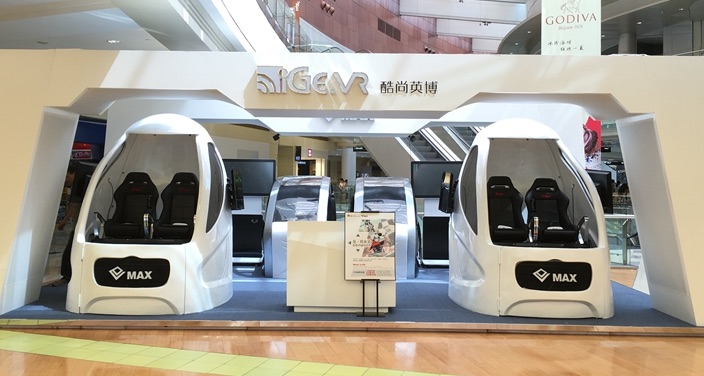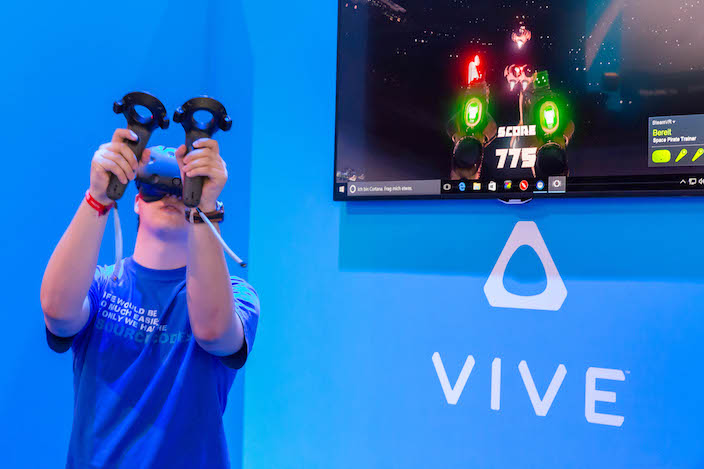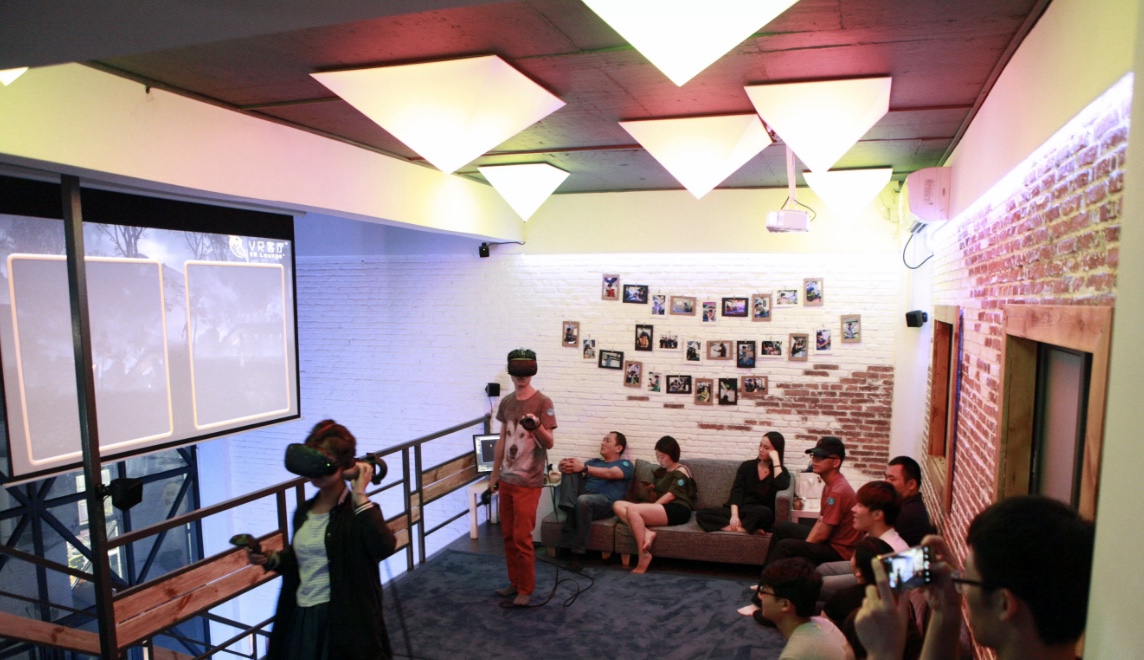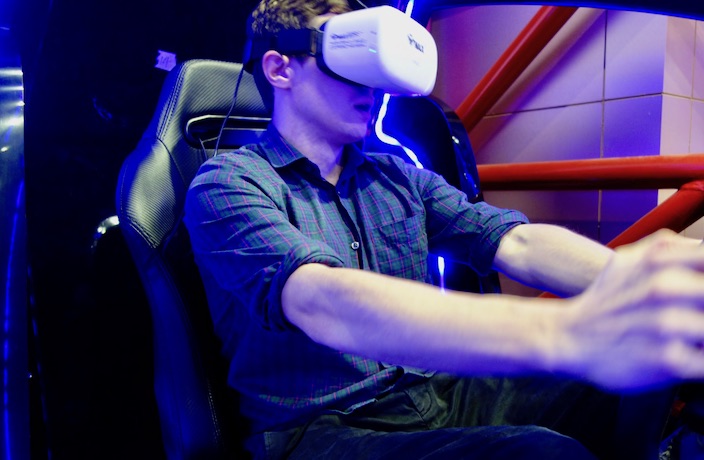Virtual reality’s introduction to the world was an amazing failure.
The Sensorama used a 3-D film to simulate a motorcycle ride through Brooklyn, complete with blowing wind and a seat that rumbled with the motion of a mock engine.
The year was 1962.
Designed for arcade-like use, it was an impressive invention, but producing the Sensorama was deemed too expensive and complicated to be commercially viable. American cinematographer Morton Heilig would never sell his visionary machine.
 The Sensorama was ahead of its time in 1960, with similar technology only being embraced now.
The Sensorama was ahead of its time in 1960, with similar technology only being embraced now.
The same can’t be said for Emax project manager Fuli Cheng, 31, one of the many people riding the resurgence of VR (virtual reality) technology. Sitting outside a VR cafe in Shenzhen wearing a plaid shirt and khaki pants, Fu looks like a white-collar worker enjoying his weekend.
“It’s only been two years, in that time we’ve developed about 300 experience shops on the Chinese mainland,” Fu says before taking a sip of his coffee. “It’s crazy.”
Just as the Sensorama would have done, experience shops have given the curious a chance to try VR. For about RMB50, customers can sit in devices like Emax’s Eggmax, which moves a pair of seats in sync with images displayed in VR headsets. There is even a vent blowing wind.
Emax hardware is used in about 300 experience shops in China and 60 in South Korea, says Fu, who told a Belgian delegation in October that Emax makes a monthly revenue of about RMB30 million by targeting upscale malls.
 Emax experience shops have targeted malls in China.
Emax experience shops have targeted malls in China.
“In Japan we don’t really have VR things. But in Shenzhen it’s all over the place,” said Forbes Japan reporter Yuji Ueda walking through a Shenzhen shopping center. “There’s nothing like this.”
Outside of China, the pay-to-play concept may not be as widespread, but it has been applied on a grander scale, with VR attractions opening in Utah and New York’s Times Square last year. Called The Void, visitors strapped a computer to their backs, allowing untethered movement through a virtual world supplemented by very real walls, mist machines and heat lamps.
And while the technology made its presence felt globally in 2016, there is little doubt the high-water mark was reached on the Chinese mainland, with up to 4,000 experience shops running as of last April, according to the China Electronics Standardization Institute.
Yet, a five-minute ride in a shopping mall falls short of the VR we were promised during the technology’s rebirth in the 90s, when it was touted as something you would use at home. By the mid 90s – and with the 1996 failure of Nintendo’s Virtual Boy system – it became apparent the technology simply wasn’t ready.
This was supposed to change in 2016, when VR headsets were released by Sony, Facebook-backed Oculus and HTC.
 The HTC Vive launched in April of 2016 and in November HTC signed agreements with the Shenzhen government worth RMB10 billion.
The HTC Vive launched in April of 2016 and in November HTC signed agreements with the Shenzhen government worth RMB10 billion.
Dutchman Patrick Weermanam bought into what he views as the future.
“I put [the HTV Vive] on and after that I was sold. It brought me back to being a little kid 20 years ago,” said Weermanam, who lives in Dongguan and is developing a Tetris-like VR game. “You get your first mobile phone, you get your first computer. It’s that kind of feeling.”
China hopes to be front and center in the development of VR, with the government having already created various funding schemes to have the technology developed domestically.
In November, the Shenzhen government and Taiwan-based electronics company HTC signed a two pronged agreement, with HTC receiving government support to create a China VR Research Institute. The agreement will also see HTC get help establishing a RMB10 billion VR research fund, according to a press release.
The deal remains grand and vague, however, with Fu uncertain when “the money will come down.”
Money or not, the technology is spreading at a grass-roots level, but not always in ways industry insiders believe is healthy.
Experience shops rankle the sensibilities of purists like Martin Meissner, who calls the simulated rides “a bit of a cash grab.” Meissner’s efforts to bring VR to the public – while creating a content management system – took the form of the brick and mortar VR Lounge in Shenzhen’s Bao’an.
After months of construction, it opened to word-of-mouth fanfare, pitting teams of players against each other.
“If we weren’t the first one doing this, we were one of the first ones,” said Meissner.

Now a search on Dianping in China’s major cities turns up hundreds of lounges allowing you to pay for a VR experience, some of the businesses being little more than a rented office and a VR headset.
Despite becoming more commonplace, VR still isn’t ready for a place in the living room between the television and computer.
The technology still causes motion sickness in some, possibly caused when images projected in the headset lag behind the movement of the head. And even if the problem is solved, the updated hardware may not make it into consumers’ hands until 2018.
“The next difficulty is finding a killer app, like a Super Mario for the NES, or Sonic for Sega,” said Meissner. Game developer Weermanam agrees, adding that knowledge of how to properly make VR software is also a huge roadblock.
“You don’t have a teacher, no one can tell you what is good and what is wrong,” said Weermanam, who provided video of his game, but couldn't demonstrate it because of a recent coding error. “For every problem you have, there is no answer.”
Although the answers are likely to come as major companies like Google, Facebook and Tencent invest in VR technology, there remains a much more material barrier: the price.
The HTC Vive system costs more than RMB6,000 and requires an equally expensive computer to run it.
“These companies can’t demand such high prices and expect to be widely adopted,” said Attilla Csanyi, whose VR men’s health product raised USD144,300 on Indiegogo. Though Csanyi believes market competition will eventually push VR hardware prices down.
Back in the VR Cafe, Fu asks a person how they feel after a simulated amusement park ride in an Emax product. The answer? A bit dizzy.
“You see there are some problems with the technology,” Fu says. When asked when VR technology will be ready for the home, his answer is simple: “It’ll be about five to ten years.”
That's PRD web editor Matthew Bossons saw first hand how VR could be both an immersive and dizzying experience in the video below (VPN off):
READ MORE: We Tried Virtual Reality in Guangzhou
[Images via emaxvr.com, Wikimedia, Quartz, Yuji Ueda]





















0 User Comments